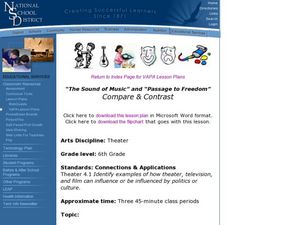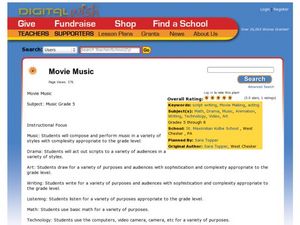Reading Resource
/ue/ Word List
The final resource in a series of 16 phonemic awareness activities, designed to develop the awareness skills needed to detect the vowel sounds in words, features the /ue/ sound. Kids identify and highlight the /ue/ sound in a list of 13...
Houghton Mifflin Harcourt
Animal Habitats: Extra Support Lessons (Theme 4)
The activities and exercises in this packet, the third in the series of support materials for the Houghton Mifflin Harcourt thematic units on animal habitats, are designed for learners who need extra support with the basic concepts of...
Roy Rosenzweig Center for History and New Media
Yankee Doodle: How Has It Changed over Time?
Grab your feathers and your hat! And perhaps some macaroni! It's time to investigate the evolution of "Yankee Doodle Dandy." Groups do a close reading of sheet music covers, lyrics, and even YouTube videos to see how this political song...
Curated OER
Teach Like a Pirate Hooks
Sail the mighty seas of lesson planning with a set of ideas fit for any pirate... or swashbuckling teacher! This here collection of cards includes groups of questions to ask yourself when you find yourself caught in a lesson planning...
Curated OER
Lines of Symmetry
Young scholars practice dance to divide the space or body shape into equal sections to create symmetry in dance. In this symmetry lesson, students practice symmetrical and asymmetrical movements in dance. Young scholars participate in...
Montana Office of Public Instruction
Eat Smart Be Smart
Get children's blood pumping with this primary grade lesson on the human heart. After learning about the important role this muscle plays in the human body, students monitor their heart rates and discover the importance of staying active.
Curated OER
Realism in Music, The Underground Railroad
Students complete a unit of 9 lessons to learn about realism in music during the time of the Underground Railroad. In this music realism lesson, students learn about coded lyrics in the slave songs. Students complete 9 lessons using...
Curated OER
Forming Relationships Using Music & Rhythm
Students make connections to other cultures and traditions through music, dance, art, and poetry.
Curated OER
American Music Genres
Students research and listen to a variety of American music genres and create a written comparison between three of the styles.
Curated OER
Hip Hop and Political Activism
Young scholars identify and employ non violent methods/tactics to bring about social change as exemplified in hip hop culture. They examine hip hop as a form of political activism.
Curated OER
African American Music
Students investigate a variety of sites to gather relevant information for a
presentation about African American musical forms in this general Music lesson plan for middle school and high school. Resource links are provided to aid...
Curated OER
Music in Other Cultures
Students examine the musical concepts of timbre, melody, and rhythm. They listen to and identify characteristics of music from other cultures.
Curated OER
Music Appreciation Lesson
Students discover the freedom of dance by performing physical expression with music. For this physical education lesson, students discuss ways their body can make noise such as snapping, patting, or stomping. Students utilize their...
Curated OER
I Went to the Crossroads: The Faust Theme in Music, Film and Literature
Students analyze song lyrics and discuss Faust theme in musical history. In this thematic lesson, students view a film clip and create a song lyric, poem or short story developed around the Faust theme. Students perform or present their...
Curated OER
The Sound of Music and Passage to Freedom
Seventh graders examine music examples to investigate a conflict in history about Hitler's invasions during WWII. In this music analysis lesson, 7th graders discuss vocabulary and the history for the Holocaust and Hitler's invasions....
Curated OER
Activities Using Music From Saint-Saens & Moussorgsky
Student create a fish and listen to music while imagining their fish are swimming. In this music activity, students identify instruments played and move their fish to the movement. Students work with kangaroos and elephants to music...
Curated OER
Glue Fish
Get out the glue and those oil pastels its time for an art project. The class explores shape, art, and color as they draw fish with glue, let them dry, and then color them as they wish. This project would be wonderful after discussing...
Curated OER
Dragonfly Sculptures
Art projects are great when they apply to other subjects. First study insects, their parts, and their habitats. Then have little ones create a dragonfly. They use clothes pins, raffia, pipe-cleaners, and paint to construct their...
Curated OER
Clay Gargoyles and Grotesques
Grotesques or gargoyles are wonderful subjects for stories or art projects. Here is a simple "how to" for creating a lesson about sculpting clay gargoyles. Tip: Have learners research gargoyles throughout history.
Curated OER
Mixing Colors with Corn Syrup and Food Coloring
Anyone who has worked with small children know that color identification and color mixing can be fun! This simple idea has a lot of potential. It suggests to mix food coloring with corn syrup to provide an opportunity for color mixing...
Curated OER
Movie Music
Young scholars discover film making by participating in a music performance. In this performance arts lesson, students perform music and physical acting to convey an already written script for their peers. Young scholars collaborate...
Curated OER
Music in Nature
Students research the Incan civilization. For this Incan civilization lesson, students study the geography of the Andes mountains and play an Andean siku. Students discuss how the sounds of nature influenced their musical piece.
Curated OER
Musical Phrase Completion
Young scholars get to encounter simple musical notations, basic keyboarding and improvisation. Students exercise on creative thinking skills. Young scholars create their own musical notes.
Curated OER
Caribbean Music
In this music worksheet, students identify and describe various famous dances and music of the Caribbean. They respond to questions about each of the three types described in the activity.

























